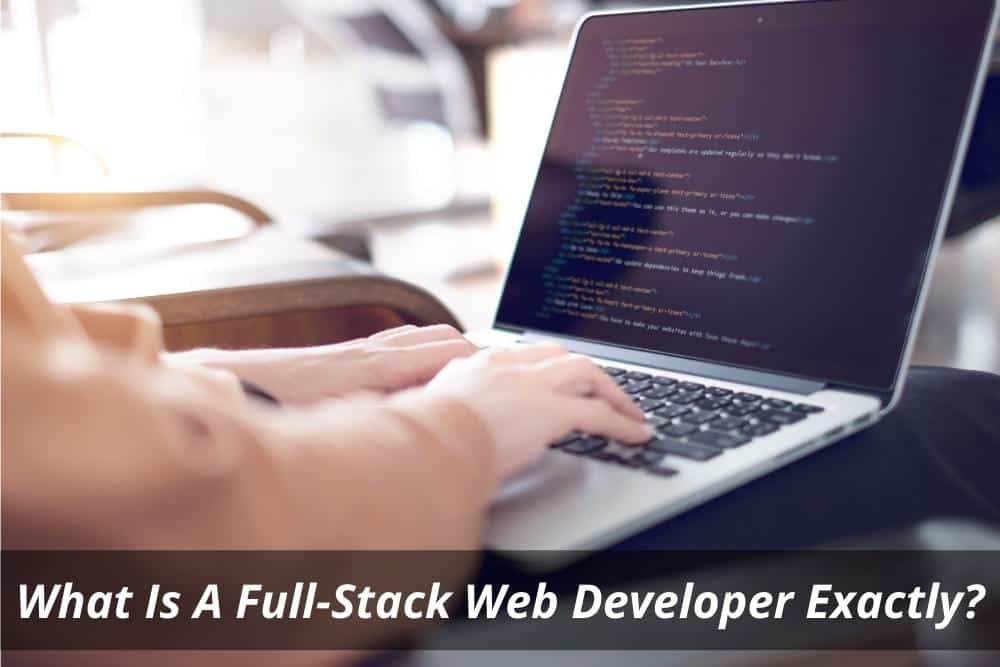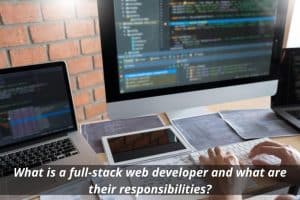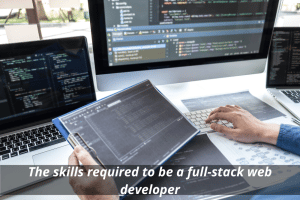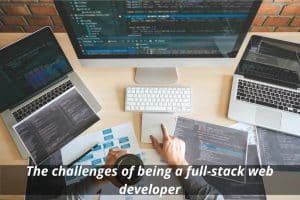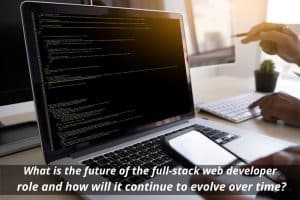The term “full stack web developer” has become increasingly popular over the past few years. But what does it actually mean?
In simple terms, a full-stack web developer is someone who can develop both the front-end and back-end of a website or application.
Front-end development generally refers to the work involved in building the user interface and experience for a website or application. This includes things like the design, layout and interactivity of a site. Back-end development, on the other hand, deals with everything that happens behind the scenes. This includes things like server-side scripting, database interactions and security.
In order to a be full-stack web developer, you need to have a good understanding of both front-end and back-end development. This means being able to code in a variety of programming languages, as well as having a strong grasp of principles like user experience (UX) design, database design and management, server administration and deployment.
While it is possible to learn all of these things yourself, it is often more efficient to specialize in one area or the other. Full-stack developers who are able to expertly handle both the front-end and back-end aspects of web development are rare and highly sought-after.
1. What is a full-stack web developer and what are their responsibilities?
Full Stack Web Development generally refers to the development of both front-end and back-end web applications. A Full Stack Web Developer is responsible for developing and managing all aspects of a website, from the initial design all the way through to the final user experience.
The Full Stack Web Developer role is a relatively new one, only emerging in the last few years as the need for more comprehensive and integrated web development solutions has arisen. Full Stack Web Developers are in high demand as they are able to provide businesses with end-to-end web development services, from concept all the way through to delivery.
The Full Stack Web Developer role is a highly technical one and requires a deep understanding of both back-end and front-end web development technologies. Full Stack Web Developers must be comfortable working with a wide range of programming languages, databases, tools and frameworks.
Full Stack Web Development is not for the faint-hearted – it is a demanding role that requires a great deal of knowledge, skill and experience. But for those up to the challenge, Full Stack
Web Development can be an immensely rewarding and satisfying career.
2. The skills required to be a full-stack web developer
In order to be a full-stack developer, one must possess a wide range of skills. These skills include everything from front-end design and user experience to back-end development and database administration.
While it is possible to specialize in one particular area, most full-stack developers have at least a working knowledge of all aspects of web development. This allows them to build comprehensive web solutions that are both functional and aesthetically pleasing.
Some of the key skills that all full-stack web developers should have include:
HTML/CSS: Full-stack developers must have a strong understanding of HTML and CSS. They should be able to hand-code clean and well-organized markup that meets modern web standards. In addition, they should be able to use CSS to create visually-appealing stylesheets.
JavaScript: JavaScript is an essential skill for any web developer. They should be able to write and understand both vanilla JavaScript and popular frameworks such as jQuery. In addition, they should be familiar with AJAX and other methods of asynchronous data retrieval.
PHP: PHP is a widely-used server-side scripting language that is perfect for building dynamic websites and web applications. Full-stack developers should have a strong understanding of how to write PHP code that is efficient and secure.
MySQL: MySQL is the most popular database management system in the world. Full-stack developers should know how to design databases, write SQL queries, and perform other common database tasks.
These are just a few of the skills that are necessary to be a full-stack developer. In addition to these technical skills, full-stack developers must also have strong problem-solving abilities and be able to work independently. With the right mix of skills and experience, anyone can become a full-stack web developer.
3. How to become a full-stack web developer?
The best way to become a full-stack developer may vary depending on your individual skillset and experience. However, there are certain steps that you can take to become a full-stack web developer.
Some of the most important skills for a full-stack web developer include:
- Strong knowledge of HTML, CSS, and JavaScript
- Strong knowledge of at least one server-side programming language (such as PHP, Ruby on Rails, or Node.js)
- Strong knowledge of database technologies (such as MySQL, MongoDB, or Cassandra)
- Familiarity with front-end frameworks (such as AngularJS or React)
- Familiarity with content management systems (such as WordPress or Drupal)
- Familiarity with version control tools (such as Git or SVN)
In addition to the above skills, it is also important for a full-stack developer to have strong problem-solving skills and be able to work independently. Full-stack developers must also be able to effectively communicate with both technical and non-technical team members.
If you are interested in becoming a full-stack web developer, there are a few different ways to go about it. One option is to complete a coding Bootcamp, which will teach you the necessary skills to become a full-stack web developer. Another option is to complete a traditional four-year computer science degree.
Whichever route you decide to take, it is important to remember that becoming a full-stack developer requires a lot of hard work and dedication. However, the rewards can be well worth it. Full-stack web developers are in high demand and can command high salaries. They also have the satisfaction of knowing that they are able to build websites from start to finish. If you have the passion and drive to become a full-stack developer, then there is no reason why you cannot achieve your goal.
4. The benefits of becoming a full-stack web developer
As a Full Stack Web Developer, you will have the ability to work on both the front end and back end of web applications. This means that you will be able to create user interfaces as well as interact with databases. Full Stack Developers are in high demand because they can build web applications from start to finish.
Some of the benefits of becoming a Full Stack Developer include:
- You will be able to build web applications from start to finish
- You will have a better understanding of how the whole web application works
- You will be able to find more job opportunities since Full Stack Developers are in high demand
- You will be able to earn a higher salary than Front End Developers and Back End Developers
If you are interested in becoming a Full Stack Developer, then you should start by learning the basics of HTML, CSS, and JavaScript. Once you have mastered these technologies, you can then move on to more advanced topics such as PHP, Ruby on Rails, and Node.js. Full Stack Developers need to have a strong understanding of both the front end and back end of web applications in order to be successful.
5. The challenges of being a full-stack web developer
As a Full Stack Developer, you are responsible for both the front-end and back-end development of a website or application. This means that you need to have a strong understanding of both web design and programming.
While Full Stack Developers are in high demand, the role can be challenging. Here are some of the challenges you may face:
- Keeping up with new technologies
- Learning multiple programming languages
- Working with different teams
- Managing website hosting and databases
- Debugging errors and issues
- Testing and deploying code changes
- Balancing work with life outside of work
- Securing data and protecting user privacy
- Dealing with system downtime
- Providing customer support
Despite the challenges, Full Stack Developers are essential to the success of many businesses and organizations. If you’re up for the challenge, consider becoming a Full Stack Developer!
6. What is the future of the full-stack web developer role and how will it continue to evolve over time?
The Full-Stack Developer role has been around for a few years now and it doesn’t seem to be going anywhere. In fact, as the web continues to evolve and become more complex, the Full-Stack Web Developer role is only going to become more important.
So what exactly is a Full-Stack Web Developer? A Full-Stack Web Developer is somebody who can build and maintain a website or web application from start to finish. This means they need to be able to work with both the front end (the part of the website that users see and interact with) and the back end (the server-side code that makes everything work).
Being a Full-Stack Developer requires a very diverse skill set. You need to be able to code in a variety of programming languages, have a good understanding of server administration, and know how to create and use databases. You also need to be able to put all of this together to create a cohesive user experience.
The Full-Stack Web Developer role is only going to become more important as the web continues to evolve. As more and more businesses move online, there is going to be an increased demand for people who are able to build and maintain complex websites and applications. If you’re considering a career in web development, then full-stack is the way to go.


